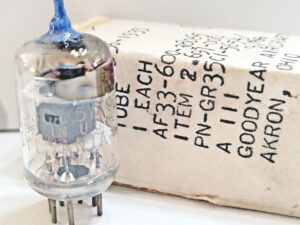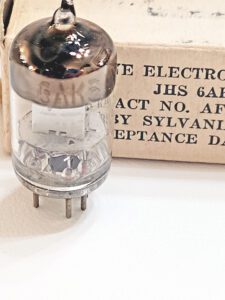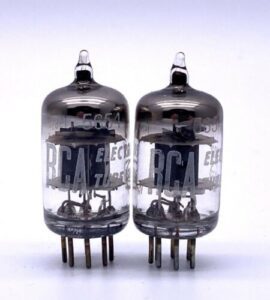Tube Rolling the Xduoo MT-604
This is my notes for tube rolling the Xduoo MT-604 balanced amplifier. For a full review of the 604, please see my review.
For those of you who have read previous Tube rolling articles and want to skip some of the background, jump down to the Tube Rolling Notes section.
I have previously discussed the 6J1 tube in my article on Tube rolling the Ta-02 and Ta-05 amplifiers and again in the MT-602 tube rolling article so for more background on the 6J1 and its family please see those two articles. If you want to learn a bit more about tubes before diving into a specific one, I recommend reading the introduction to tubes article here. Some of the block below is included in the intro article, but it bears repeating.
First a few notes that apply to all tubes:
When removing on seating tubes, never rock the tube in the socket as this is a great way to loosen the socket. Often poor tube performance is a result of poor connectivity. Seat and remove tubes by holding the unit in one hand, and the tube in the other and moving the tube vertically.
Never trust an ebay seller who says a tube is “Just like” another tube type. Unscrupulous sellers will tell you tubes can be interchanged in order to dump what they have in stock and don’t care if it destroys your equipment as it will usually take long enough to do so that you won’t be able to put it back on them. When in doubt, consult the spec sheets.
There is no such thing as a tube that sounds good cold. All tubes have to warm up to perform and may need an hour or more to do so. All testing done here was with tubes that had been preheated at least an hour before listening.
Tubes may need to having matching internal sections (dual triode or dual pentode for example) or be paired (two tubes that are equal) in order to perform well in a circuit. This depends on design and the ability to adjust bias, current, etc. outside the tube. Generally, the simpler the design, the more important having well matched tubes is. More complex designs may have other compensation mechanisms.
A brief history of the 6J1:
While known as the 6J1 in China and Russia, in the west this tube is more commonly known as the 6AK5 or 5654, and also as the EF95 in Europe. The tube was originally developed by Western electric for early radar systems and was used extensively in IF amplifiers during WW2 through the 1950s. The tube is a 7-pin miniature pentode that has the grid placed closer to the cathode than standard and uses a very fine mesh for the grid that gives it excellent high-frequency performance. The drawback to this close spacing is that thermal drift can become an issue as the tubes heat up. Expansion of various components can lead to differing tolerances, plate voltages etc. and can be audible if QC is not extremely tight. This is one reason the military grade tubes (JAN 5654W marked) are so popular as they were both improved to limit this issue, and very stringently tested at the time of production. Commercially, the tube was widely used in VHF amplification and was commonly seen in TV sets and radios and while these applications still require a good deal of precision, QC varies between brands and eras among the commercial tubes. Audio use has generally been in guitar effects pedals, microphones, pre-amps, and headphone amplifiers as it has a lower output than needed for larger wattage applications.
Note: JAN is joint army/navy and indicates the tubes were originally packaged for military use in the US. CV (Common Valve) is a similar designation used by the UK military. US JAN tubes often will specify a maker on the box while it was strictly forbidden to label the tube with a maker’s mark for tubes sold as CV. Lot numbers can be used to trace CV tubes back to their original maker.
In general, the 6J1, EF95, 6AK5, and 5654 labeled tubes are considered the standard models. The 6J1p-EV, 5654W, 6AK5W, and CV4010 were built to military standard often with longer lasting components and to tighter standards and will command a premium as a result. The 6096 was built as a premium tube as were the RCA Command tubes and generally will command a higher price yet, and from there prices can go into the stratosphere for rare tubes and exotic makes or early tubes by a specific maker.
There are a wide variety of options for the 6J1 including:
| 6J1 | This label is most commonly used by Chinese makers Peking, and Shuguang |
| 6J1P-EV | This label is most commonly seen on Russian produced tubes from Voskhod and Novosibirsk |
| 5654 | This was the original western name used in the US with common brands including, Westinghouse, RCA Command, National, Amperex, and RadioTechnique |
| 5654W | The W designation was an improved 5654 version and is most commonly seen as military tubes (JAN) made by RCA, GE, and Sylvania |
| 6AK5 | The 6AK5 was another western designation with brands including Tung-Sol, Siemens, National, and Ericcson |
| 6AK5W | An improved 6AK5 with typical brands including Raytheon, Mullard, and Telefunken |
| CV4010 | British Military designation (Common Valve) most commonly seen made by Mullard |
| 6096 | Premium 5654 Model often seen made by GE, Tung-sol, Sylvania, and Mullard |
| EF95 | European designation often seen made by Phillips |
| 403b | Early western designation used by Western Electric |
MT-604 Tube Rolling Notes
Since the MT-604 is balanced and differential, we need one tube per signal path resulting in a need for 4 tubes. Within a channel, the tubes need to be fairly well paired as they represent the positive and negative signal paths that will be paired as an output. Variations in tubes within the pair can result in some odd sonic behaviors. Variation between tubes used for left and right channels is less critical as separate volume controls allow for independent adjustment and leveling. I found it best to use my calibrated mic to level set the 604 and then use a pre-amp to control volume rather than trying to volume match using the controls on the 604. At best, I could volume match to within about 3-4dB by ear vs getting a near exact match by measuring outputs.
I have tried to use the same selection of tubes used with the 602 and for the most part was able to do so. The need for two matched pairs did limit the sample size some as there are one or two I tested in the 602 that I simply did not have 4 good examples of for the 604 testing (1945 WE). I was able to test using the original 6J1 Chinese tubes to give a baseline before introducing CV4010 Mullard, 6ak5 Siemens and Sylvania, Several 5654(w) models (RCA, GE, Raytheon) ,Voskhod 6j1P-EV and 403b Western Electrics. This gives a pretty good cross section of what is available but is by no means all inclusive. Remember, that this is my opinion and others will undoubtedly feel differently, and these observations are only applicable to use in the MT-604. Use in other devices may yield entirely different results.
My notes here are focused on differences from the stock 6J1 Shuguang made tubes that ship with the unit. The tubes that shipped with my unit showed poor QC as all 4 had different heights both from table to pin-base and from table to top. While all 4 showed the same date code, there is no doubt in my mind that either they were labeled after the fact or came off different production lines. Putting them on my Hickok tube tester showed varying results as well so these were not matched either physically or electrically before installation in the amp. Hopefully your sample will come with better tubes but it is likely wise to plan on replacing them just in case it doesn’t.
Shuguang 6J1
 The QC on these is below average for sure, if you enlarge the photo, you’ll notice that the height from table to base (pin length) is different on several of them, there are two different base styles, and the glass is different heights on all of them. They certainly don’t look the part, but they sound acceptable with decent extension and clarity. If there is a drawback to these it is that they don’t add much of anything positive to the signature as bass lacks authority and treble has some grain to it.
The QC on these is below average for sure, if you enlarge the photo, you’ll notice that the height from table to base (pin length) is different on several of them, there are two different base styles, and the glass is different heights on all of them. They certainly don’t look the part, but they sound acceptable with decent extension and clarity. If there is a drawback to these it is that they don’t add much of anything positive to the signature as bass lacks authority and treble has some grain to it.
CV4010 Mullard:
I’ve now had basically the same experience with this tube in multiple amps and will say those expecting a Mullard signature will be disappointed in these. The lush full tones Mullard is known for simply are not on display here. The Cv4010 does have a a little more low end extension and a better stage but only marginally better treble and not a lot of added warmth or sparkle. Overall, not worth the premium they command in the 60x series amps.
6AK5 Siemens:
Siemens tubes can be several different makers depending on location of purchase and specific tube, my 6AK5 are Valvo made and badged as Siemens. These improve the end to end extension and treble substantially over the stock as well as improved stage. Treble is a bit more forward than the stock tube and those with treble sensitivity may prefer something less bright. These are well detailed and a definite improvement over stock but command a premium so don’t make the top 3 based on value.
6AK5 Sylvania (1958):
I called the early Sylvania tube the best of the lot in the 602 and the same characteristics that made it a favorite there are still on display here but maybe not to quite the same degree. These have good stage and extension with good clarity all the way trhough the range. In the 604, they come in 2nd as they don’t have quite the warmth of my top pick. Still, these represent good value if you can find them and may well be the best option by price.
6AK5 Sylvania (1963):
These later Sylvania tubes prove that you really don’t need blue tips or black plates to get good sound. These again displayed good end to end extension and stage dimensions with good detail as well. These are probably a bit easier to come by than the earlier tube and in the 604 are equally good so represent better value overall. Well worth a look and my 2nd best of the list.
RCA 5654W:
I had high hopes for the RCA and was hoping it would redeem itself in the 604 after having been a distant 4th place in the 602. It proved that it was not a fluke in the earlier tests as it performed nearly identically here. It is an improvement in stage and cleaner than stock but didn’t have the same extension as the Sylvania and lacks a little top end compared to the Siemens. Good overall performer but nothing stands out as special here.
GE JAN 5654W:
The JAN 5654w US Military tube manufactured by GE, much like the RCA were an improvement over the stock tube, but don’t particularly stand out above the crowd. These might be a good spare pair in case of burning out your favorite tube as they are abundant and inexpensive, just don’t expect a lot of improvements over the stock tube.
6AK5W Raytheon:
I keep trying these in an effort to find a home for them and keep failing to find any outstanding qualities to this tube. Here again, the Raytheon performed well, just unconvincingly so. It has roughly the same extension on both ends, same stage size, and slightly more treble quantity compared to stock. Here again, I’d save the $80 these will set you back and save up for something better.
Voshkod 6j1P-EV:
 Here again, I wanted to believe as they have a sterling reputation for being well made and good sounding. They are both, the problem being they are not substantially better than stock and they cost a good bit more. If you want a tube that will never need to be replaced these probably should be the choice as they were designed for Russian military use with upgraded tube heaters, heavier glass, and vibration resistance built in. The 10,000 hour rating puts them well ahead of most in longevity. So while they may not sound markedly better than stock, they should last far longer based on the seeming lack of QC of the stock tube.
Here again, I wanted to believe as they have a sterling reputation for being well made and good sounding. They are both, the problem being they are not substantially better than stock and they cost a good bit more. If you want a tube that will never need to be replaced these probably should be the choice as they were designed for Russian military use with upgraded tube heaters, heavier glass, and vibration resistance built in. The 10,000 hour rating puts them well ahead of most in longevity. So while they may not sound markedly better than stock, they should last far longer based on the seeming lack of QC of the stock tube.
403b Western electric (1962):
 Here we have our overall winner in the 604. Technically the 403b has a lower heater current than true 6Ak5/5654 tubes and are more correctly labeled a 5591 but will usually work well in 6AK5 circuits and Xduoo confirmed it was safe to use in the 60x series amps. These had end to end extension as good as any, smoothed out the grain in the treble, and added a bit of warmth to the overall that hadn’t been seen in any of the other tubes when compared to base. The Sylvania does have a slightly larger stage, but for me the warmth and clarity won the day. The 403b generally can be had in the same price range as most of the others in this round-up so should be considered the best option unless prices are marked higher than the Sylvania or Siemens.
Here we have our overall winner in the 604. Technically the 403b has a lower heater current than true 6Ak5/5654 tubes and are more correctly labeled a 5591 but will usually work well in 6AK5 circuits and Xduoo confirmed it was safe to use in the 60x series amps. These had end to end extension as good as any, smoothed out the grain in the treble, and added a bit of warmth to the overall that hadn’t been seen in any of the other tubes when compared to base. The Sylvania does have a slightly larger stage, but for me the warmth and clarity won the day. The 403b generally can be had in the same price range as most of the others in this round-up so should be considered the best option unless prices are marked higher than the Sylvania or Siemens.







